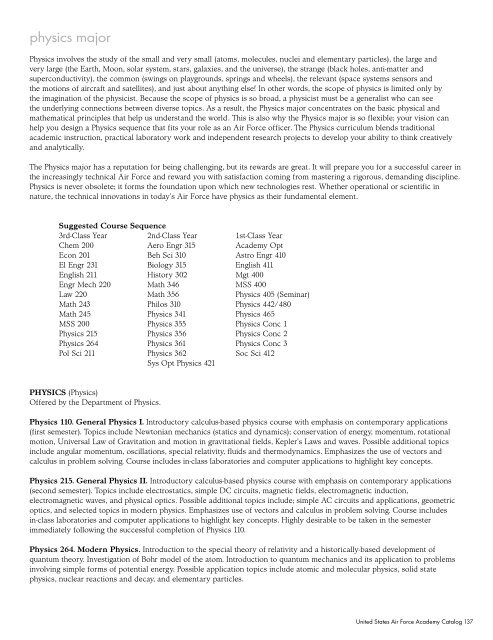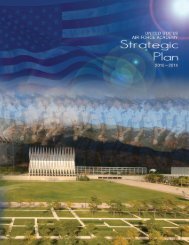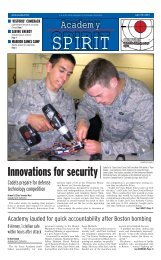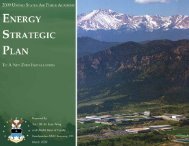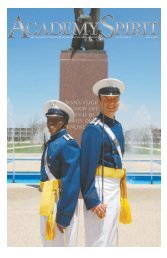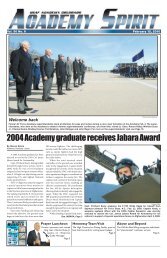2008-2009 Catalog - United States Air Force Academy
2008-2009 Catalog - United States Air Force Academy
2008-2009 Catalog - United States Air Force Academy
You also want an ePaper? Increase the reach of your titles
YUMPU automatically turns print PDFs into web optimized ePapers that Google loves.
physics major<br />
Physics involves the study of the small and very small (atoms, molecules, nuclei and elementary particles), the large and<br />
very large (the Earth, Moon, solar system, stars, galaxies, and the universe), the strange (black holes, anti-matter and<br />
superconductivity), the common (swings on playgrounds, springs and wheels), the relevant (space systems sensors and<br />
the motions of aircraft and satellites), and just about anything else! In other words, the scope of physics is limited only by<br />
the imagination of the physicist. Because the scope of physics is so broad, a physicist must be a generalist who can see<br />
the underlying connections between diverse topics. As a result, the Physics major concentrates on the basic physical and<br />
mathematical principles that help us understand the world. This is also why the Physics major is so flexible; your vision can<br />
help you design a Physics sequence that fits your role as an <strong>Air</strong> <strong>Force</strong> officer. The Physics curriculum blends traditional<br />
academic instruction, practical laboratory work and independent research projects to develop your ability to think creatively<br />
and analytically.<br />
The Physics major has a reputation for being challenging, but its rewards are great. It will prepare you for a successful career in<br />
the increasingly technical <strong>Air</strong> <strong>Force</strong> and reward you with satisfaction coming from mastering a rigorous, demanding discipline.<br />
Physics is never obsolete; it forms the foundation upon which new technologies rest. Whether operational or scientific in<br />
nature, the technical innovations in today’s <strong>Air</strong> <strong>Force</strong> have physics as their fundamental element.<br />
Suggested Course Sequence<br />
3rd-Class Year 2nd-Class Year 1st-Class Year<br />
Chem 200 Aero Engr 315 <strong>Academy</strong> Opt<br />
Econ 201 Beh Sci 310 Astro Engr 410<br />
El Engr 231 Biology 315 English 411<br />
English 211 History 302 Mgt 400<br />
Engr Mech 220 Math 346 MSS 400<br />
Law 220 Math 356 Physics 405 (Seminar)<br />
Math 243 Philos 310 Physics 442/480<br />
Math 245 Physics 341 Physics 465<br />
MSS 200 Physics 355 Physics Conc 1<br />
Physics 215 Physics 356 Physics Conc 2<br />
Physics 264 Physics 361 Physics Conc 3<br />
Pol Sci 211 Physics 362 Soc Sci 412<br />
Sys Opt Physics 421<br />
PHYSICS (Physics)<br />
Offered by the Department of Physics.<br />
Physics 110. General Physics I. Introductory calculus-based physics course with emphasis on contemporary applications<br />
(first semester). Topics include Newtonian mechanics (statics and dynamics); conservation of energy, momentum, rotational<br />
motion, Universal Law of Gravitation and motion in gravitational fields, Kepler’s Laws and waves. Possible additional topics<br />
include angular momentum, oscillations, special relativity, fluids and thermodynamics. Emphasizes the use of vectors and<br />
calculus in problem solving. Course includes in-class laboratories and computer applications to highlight key concepts.<br />
Physics 215. General Physics II. Introductory calculus-based physics course with emphasis on contemporary applications<br />
(second semester). Topics include electrostatics, simple DC circuits, magnetic fields, electromagnetic induction,<br />
electromagnetic waves, and physical optics. Possible additional topics include; simple AC circuits and applications, geometric<br />
optics, and selected topics in modern physics. Emphasizes use of vectors and calculus in problem solving. Course includes<br />
in-class laboratories and computer applications to highlight key concepts. Highly desirable to be taken in the semester<br />
immediately following the successful completion of Physics 110.<br />
Physics 264. Modern Physics. Introduction to the special theory of relativity and a historically-based development of<br />
quantum theory. Investigation of Bohr model of the atom. Introduction to quantum mechanics and its application to problems<br />
involving simple forms of potential energy. Possible application topics include atomic and molecular physics, solid state<br />
physics, nuclear reactions and decay, and elementary particles.<br />
<strong>United</strong> <strong>States</strong> <strong>Air</strong> <strong>Force</strong> <strong>Academy</strong> <strong>Catalog</strong> 137


